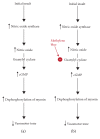Severe Undifferentiated Vasoplegic Shock Refractory to Vasoactive Agents Treated with Methylene Blue
- PMID: 29098094
- PMCID: PMC5642875
- DOI: 10.1155/2017/8747326
Severe Undifferentiated Vasoplegic Shock Refractory to Vasoactive Agents Treated with Methylene Blue
Abstract
Methylene blue is a phenothiazine-related heterocyclic aromatic molecule presently used in the treatment of methemoglobinemia. Recently, it has been implicated in the treatment of severe refractory vasoplegic shock caused by anaphylaxis, sepsis, or postcardiopulmonary bypass. We present a case of a 27-year-old male with profound vasoplegic shock of unknown etiology which was refractory to vasopressors who responded within hours to a single dose of methylene blue. Additionally, we review the evidence of methylene blue's role in the treatment of shock. This case illustrates a diagnostic approach and treatment options in the setting of undifferentiated vasodilatory shock and outlines a new and emerging role for methylene blue in this clinical setting.
Figures


References
Publication types
LinkOut - more resources
Full Text Sources
Other Literature Sources

